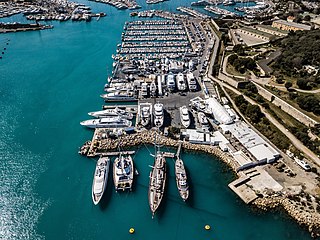
A shipyard, also called a dockyard or boatyard, is a place where ships are built and repaired. These can be yachts, military vessels, cruise liners or other cargo or passenger ships. Compared to shipyards, which are sometimes more involved with original construction, dockyards are sometimes more linked with maintenance and basing activities. The terms are routinely used interchangeably, in part because the evolution of dockyards and shipyards has often caused them to change or merge roles.

Union Iron Works, located in San Francisco, California, on the southeast waterfront, was a central business within the large industrial zone of Potrero Point, for four decades at the end of the nineteenth and beginning of the twentieth centuries.

Ship-breaking is a type of ship disposal involving the breaking up of ships for either a source of parts, which can be sold for re-use, or for the extraction of raw materials, chiefly scrap. Modern ships have a lifespan of 25 to 30 years before corrosion, metal fatigue and a lack of parts render them uneconomical to operate. Ship-breaking allows the materials from the ship, especially steel, to be recycled and made into new products. This lowers the demand for mined iron ore and reduces energy use in the steelmaking process. Fixtures and other equipment on board the vessels can also be reused. While ship-breaking is sustainable, there are concerns about the use by poorer countries without stringent environmental legislation. It is also labour-intensive, and considered one of the world's most dangerous industries.

The Port of Portland is the port district responsible for overseeing Portland International Airport, general aviation, and marine activities in the Portland, Oregon metropolitan area in the United States. Originally established in 1891 by the 16th Oregon Legislative Assembly, the current incarnation was created by the 1970 legislature, combining the original Port with the Portland Commission of Public Docks, a city agency dating from 1910.

John Brown and Company of Clydebank was a Scottish marine engineering and shipbuilding firm. It built many notable and world-famous ships including RMS Lusitania, RMS Aquitania, HMS Hood, HMS Repulse, RMS Queen Mary, RMS Queen Elizabeth and the Queen Elizabeth 2.

The South Waterfront is a high-rise district under construction on former brownfield industrial land in the South Portland neighborhood south of downtown Portland, Oregon, U.S. It is one of the largest urban redevelopment projects in the United States. It is connected to downtown Portland by the Portland Streetcar and MAX Orange Line, and to the Oregon Health & Science University (OHSU) main campus atop Marquam Hill by the Portland Aerial Tram, as well as roads to Interstate 5 and Oregon Route 43.
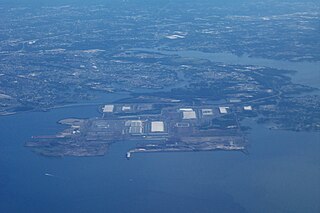
Sparrow's Point is an unincorporated community in Baltimore County, Maryland, United States, adjacent to Dundalk. Named after Thomas Sparrow, landowner, it was the site of a very large industrial complex owned by Bethlehem Steel, known for steelmaking and shipbuilding. In its heyday in the mid-20th century, it was the largest steel mill in the world. The site of the former Bethlehem Sparrows Point Shipyard and steel mill is now renamed Tradepoint Atlantic in a revitalization program to clean up the environment and make it one of the largest ports on the East Coast of the United States. Today Sparrows Point is home to many distribution centers, fulfillment centers, training lots, storage lots, and the like, including those operated by Under Armour, Amazon, Home Depot, Volkswagen, and McCormick & Company.

Commercial Iron Works was a manufacturing firm in Portland, Oregon, United States. Established in 1916, the company is best remembered today for its contribution to America's Emergency Shipbuilding Program during World War II.

Willamette Iron Works was a general foundry and machine business established in 1865 in Portland, Oregon, originally specializing in the manufacture of steamboat boilers and engines. In 1904, the company changed its name to Willamette Iron and Steel Works, under which name it operated continually until its close in 1990.
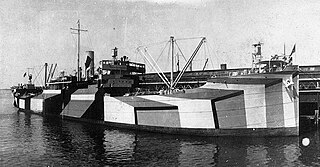
Northwest Steel was a structural steel fabricator and shipbuilding company in Portland, Oregon. During World War I the yard built cargo ships for the United States Shipping Board (USSB). Some 37 of the 46 ships ship built at Northwest Steel were the West boats, a series of 5,500-gross register ton (GRT) steel-hulled cargo ships built for the USSB on the West Coast of the United States as part of the World War I war effort.

USS Steuben County (LST-1138) was an LST-542-class tank landing ship built for the United States Navy during World War II. Named after counties in Indiana, and New York, she was the only U.S. Naval vessel to bear the name.

Sarah Dixon was a wooden sternwheel-driven steamboat operated by the Shaver Transportation Company on the Columbia and lower Willamette rivers from 1892 to 1926. Originally Sarah Dixon was built as a mixed use passenger and freight vessel, and was considered a prestige vessel for the time.

C.H. Wheeler was a schooner-rigged unpowered lumber barge that operated during the year 1901, making only a few voyages before it was wrecked near Yaquina Bay with the loss of one life. C.H. Wheeler was the largest vessel up to that time to reach Tillamook City and the first vessel to transport a load of lumber from Tillamook to San Francisco. The circumstances of the loss of the C.H. Wheeler were controversial and resulted in the arrest of the captain of the tug that had been towing the barge before it was wrecked.

Weeks 533 is a 500-short-ton (454 t) capacity Clyde Iron Works model 52 barge-mounted crane which is the largest revolving floating crane on the East Coast of the United States. It was originally ordered for bridge construction and has since been used in several notable heavy lifts.
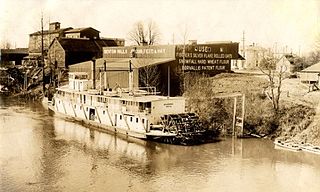
Grahamona was a sternwheel steamboat built in 1912 for the Oregon City Transportation Company, commonly known as the Yellow Stack Line. Grahamona was specially designed to serve on the shallow waters of the upper Willamette River. It was one of the largest steamboats ever to operate on the upper Willamette. In 1920, Grahamona was sold and the name was changed to Northwestern. In 1939, the vessel was sold again, and transferred to Alaska for service on the Kuskokwim River.

Green Jacket Shoal is a 33-acre (13 ha) shoal and ship graveyard in Providence River, between the cities of East Providence and Providence, Rhode Island, United States. It contains a large amount of debris from a century of abandoned and wrecked ships, destroyed docks, pilings, and other remnants of the area's industrial past. India Point, on the Providence side, was the city's first port, which remained active from 1680 until the Great Depression in the early 20th century. Bold Point, on the East Providence side, was home to a dry dock and other maritime businesses.
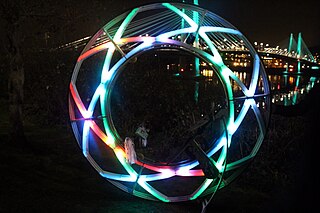
The Portland Winter Light Festival is an annual winter light festival in Portland, Oregon. Each year has been presented by the local nonprofit Willamette Light Brigade. The festival is open to the public and free to attend.
Zidell Yards is a former industrial waterfront in Portland, Oregon's South Portland neighborhood, owned by Zidell Companies and planned for development.
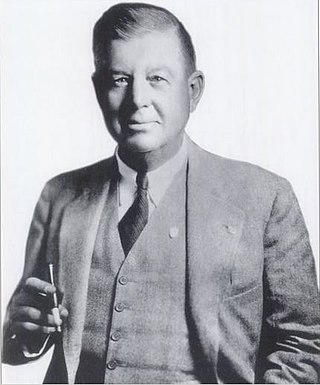
Pacific Bridge Company was a large engineering and construction company. During World War II, Pacific Bridge Company of Alameda, California was selected to build US Navy Auxiliary Repair Docks (ARD) a type of Auxiliary floating drydock and Type B ship barges.

Bethlehem Beaumont Shipyard was a shipyard in Beaumont, Texas that opened in 1948. The yard is located on an island in the Neches River and upstream of the Sabine Pass that grants access to the Gulf of Mexico. The deep-water port shipyard was founded in 1917 as the Beaumont Shipbuilding & Dry Dock Company. Beaumont Shipbuilding & Dry Dock Company started as a World War I Emergency Shipbuilding Program yard. In 1922 the Pennsylvania Car & Foundry, of Sharon, Pennsylvania purchased the yard and renamed the yard Pennsylvania Shipyards, Inc.. The yard built barges and rail cars and also operated under the name Petroleum Iron Works at the site. For World War II the yard build tugboats and barges as part of the emergency shipbuilding program. After the war Bethlehem Steel purchased the yard in 1948 as part for the Bethlehem Shipbuilding Corporation. Bethlehem Beaumont Shipyard transitioned the yard into a jackup rig offshore drilling rig yard. The yard closed in the 1980s, with the rig market collapse. Bethlehem Steel sold the yard in 1989 to Trinity Industries. Trinity Industries purchased a Panamax floating and continued operations. The Panamax floating was moved to New Orleans in 1994. Chicago Bridge & Iron Company purchased the yard in 2006. Chicago Bridge & Iron turned the yard into a fabrication yard. In 2017 Chicago Bridge & Iron Company closed the yard due to damage from Hurricane Harvey, ending work for 455 employees. Many of workers were relocated to other Chicago Bridge & Iron sites. The site is now Allegiant Industrial Island Park Campus that opened in 2018.






















